There’s something endearingly odd about the new Hyundai Veloster. The Korean maker’s latest entry — which some are comparing to the old Honda CRX, others to the Mini Clubman – is an immediate eye-catcher. But it takes a moment to realize something is just, well, different.
Start with the fact that the 2012 offering has just three doors – okay, four if you count the hatchback – one on the driver’s side and two on the passenger side. This asymmetric design is meant to give especially easy access to the coupe-like Veloster’s back seat.
No, it’s not the first three-door we’ve seen. Saturn was there before, but the rear gangway was a “suicide door” design that also required you to open the front passenger door first. No such complications for the 2012 Hyundai Veloster, which has a conventional and surprisingly large third door. But that only underscores the functionality that has been blended with distinctive styling. If this were an ice cream sundae, the cherry on top would be the Korean offering’s surprisingly affordable price tag, which starts at just $17,300 – plus another $760 in delivery charges.
No, that’s not going to make it the cheapest car on the market, despite Hyundai’s traditional positioning. You can find several models for less – including Hyundai’s own 2012 Accent. But few offer the features and the fun-to-drive attributes of the 2012 Veloster.
We had our first chance to drive the car during an extended trip to Portland, an appropriately quirky backdrop for the distinctive little Veloster.
Hyundai was long known for delivering cheap and cheerful products but the Korean carmaker has been delivering a series of surprises in recent years that have transformed its image. True, products like the latest Sonata and Elantra models still fall into the “affordable” category for their market segments, but their distinctive styling has posed a challenge to even more established, up-market brands like Toyota, Chevrolet and Volkswagen.
Now comes Veloster. And what you discover once you open one of those three doors is a product that’s surprisingly well-equipped and lavishly appointed. It’s easy to forget you’re looking at an entry-level offering that might have traditionally been foisted off on one of the kids. This is the sort of product mom or dad might be happy to take to work or use to run errands.
The seats are reasonably comfortable, the instrument panel, with its well-grained and chrome-accented trim looks decidedly up-market. The new model features a reasonably good base audio system and plenty of high-tech features, including Bluetooth hands-free phoning and an iPod/USB connection.
The interior is roomier than one might expect, with enough rear seat room to allow for two adults to squeeze in without a shoehorn. The cargo compartment is also roomy enough for a week’s groceries and then some.
Veloster currently comes with a stock 1.6-liter direct injection inline-four, the same powerplant found in the newest Hyundai Accent. It makes an acceptable 138 horsepower and 123 lb-ft of torque, enough to launch the 2700-pound Veloster from 0 to 60 in around 9 seconds.
That is, of course, on flat and level surfaces. Running around Portland, we found the engine had to work overtime to address some of the steeper terrain, requiring fairly frequent shifting of the manual gearbox. To our surprise, we found it much more fun to run around town with the 6-speed twin-clutch package, which Hyundai has dubbed EcoShift. The dry clutch design is surprisingly smooth and seamless and, these days, may appeal as much to performance-minded buyers as the stick.
Hyundai officials denied rumors of a second engine, perhaps a turbocharged version of the 1.6-liter I-4, though they pointedly said they would “never say never.” Another option might be the Elantra’s bigger 1.8-liter naturally aspirated powerplant. But we’ll put money down that a turbo 1.6 shows up within the next 12 to 18 months.
For now, Hyundai will focus its marketing on the fuel economy of the Veloster, the new model the latest in a growing line-up delivering 40 mpg. To be more precise, the 2012 hatchback gets 28 City and 40 Highway with the 6-speed stick. Curiously, the manumatic EcoShift adds another mile per gallon around town but loses two on the open road, at 29/38.
As we left town for a long drive up the Columbia River gorge we discovered that the new 2012 Hyundai Veloster makes up for the lack of power with a well-tuned suspension – which features a McPherson strut front and torsion beam rear. We found the ride to be comfortable yet firm, with plenty of grip in the corners.
As with other recent Hyundai entries, the maker has adopted a new electric power-assist steering system, or E-PAS in industry lingo. There’s still a bit of an artificial feel, but it’s responsive despite only a moderately precise on-center feel. A bit of tweaking could really turn the Veloster into the sort of machine performance fans love – especially if we get a more powerful engine. (Hyundai, are you listening?)
The 2012 Hyundai Veloster will enter a crowded market, with offerings ranging from the Clubman, at the high end, to the likes of the Scion tC, Honda CR-Z and even the sibling Korean offering, the Kia Koup.
Hyundai’s offering isn’t the fastest, nor even the most fuel-efficient – the hybrid CR-Z laying claim to that – but it is perhaps the best balanced offering, with a distinctive look, great functionality, a refined feel and plenty to offer for the price tag.
At a background session, Hyundai officials pointed out that they’ve seen a significant uptick in recent years among those willing to consider one of the brand’s products. In light of recent offerings like the Sonata and Elantra we understand why. The 2012 Hyundai Veloster will only increase that appeal.

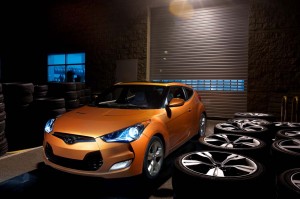
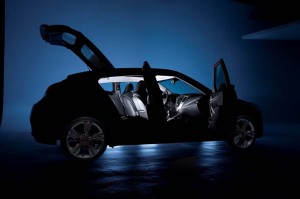
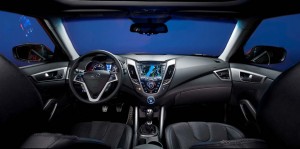
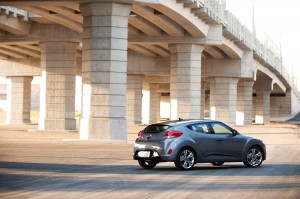
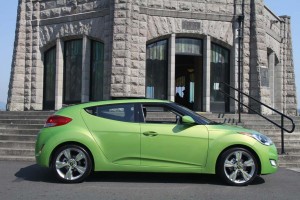
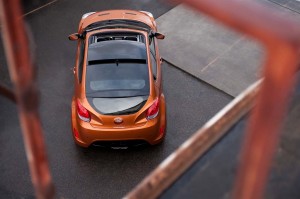
I like the interior design, which is consistent with the exterior styling. The materials quality is pretty good, but if you’re a stickler for soft-touch surfaces, the Veloster will disappoint you.